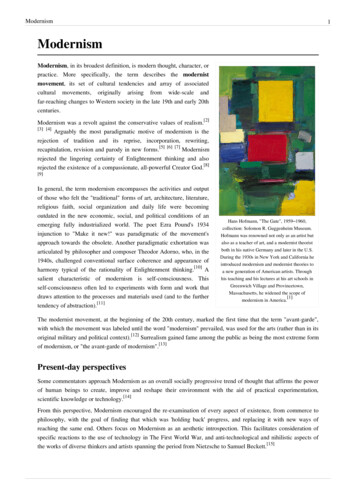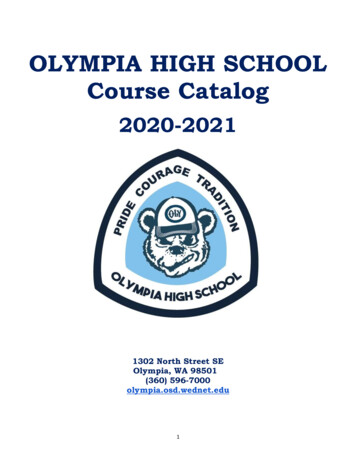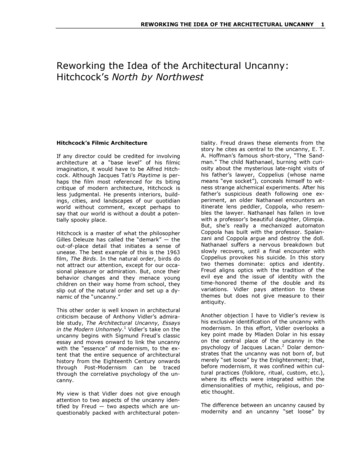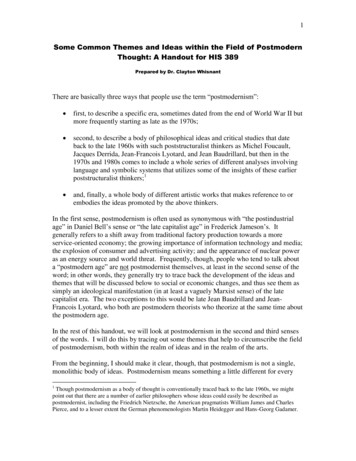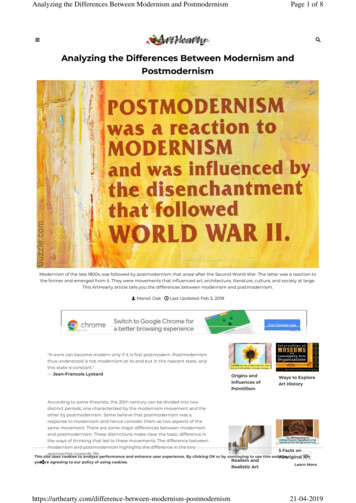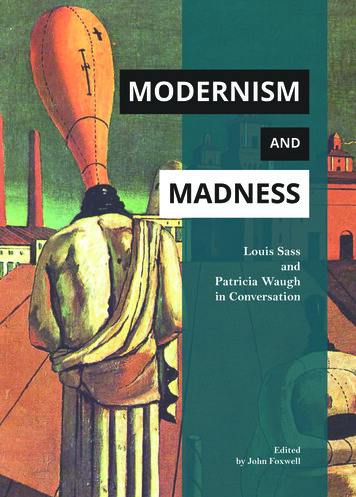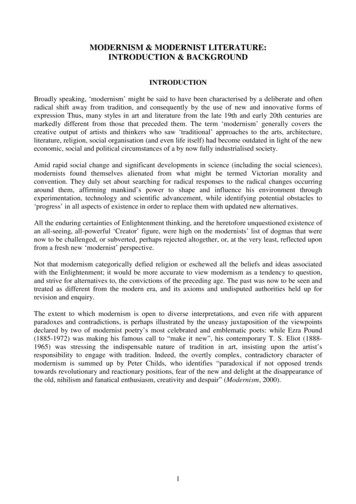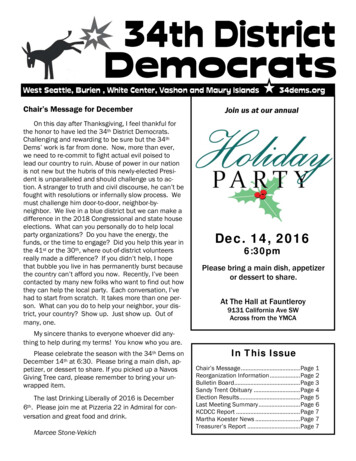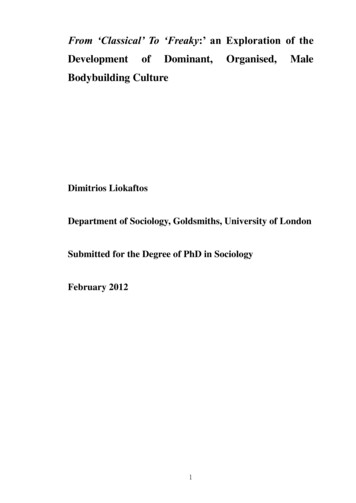
Transcription
OLYMPIAMODERNISMA self-guided tour of mid-century buildingsHeritage Commission
1KGY Radio Station2Georgia Pacific Plywood Co. Office3Medical Arts Center4Memorial Clinic5Capital Center Building6Capitol Lake Restrooms7Seattle First National Bank –Olympia Branch8Goldberg’s Furniture Store9Olympia Federal Savings & Loan10 Capital Savings & Loan11 Metropolitan Life InsuranceCompany12 Sears Department Store13 Ramada Inn14 Evergreen Plaza15 Washington Mutual Savings Bank16 Golden Gavel Motor Hotel17 1007 Washington Building18 120 Union Ave Building19 State Parking Garages20 General Administration Building31 Sunset Life Insurance Co.Headquarters32 Dick Lewis Pontiac-CadillacDealership33 Washington State Employees CreditUnion34 Olympia City HallGoogle Maps, 2010
15 Washington Mutual Savings Bank16 Golden Gavel Motor Hotel17 1007 Washington Building18 120 Union Ave Building19 State Parking Garages20 General Administration Building21 State Archives Building22 Department of Highways &Licensing Building23 Dept. of Social & Health ServicesBuilding24 Water Garden Fountain25 Highway Administration Building26 Employment Security Building27 IBM Building28 Capitol Center Apartments29 Washington State Library30 Olympia Medical - Dental Building31 Sunset Life Insurance Co.Headquarters32 Dick Lewis Pontiac-CadillacDealership33 Washington State Employees CreditUnion34 Olympia City HallGoogle Maps, 2010
1 – KGY Radio Station1240 Washington St NEArchitect: Robert Wohleb, 1960\KGY Radio, one of the oldest radiostations in the United States, beganlife at St. Martin’s College in 1914. Thestation, originally heard in 23 states,officially procured a license from theFederal Communications Commissionto operate in 1922. After outgrowing itsspace in the Rockway-Leland Building,KGY hired architect Robert Wohleb todesign a studio at the tip of the portpeninsula. Built on pilings directly abovethe water, it is one of the most uniquelysituated stations in the country.2 – Georgia Pacific PlywoodCo. Office600 Capitol Way NArchitect: Naramore, Bain, Brady& Johanson, 1952Constructed as a unique marketing tool forthe Georgia Pacific Plywood Company, thisbuilding demonstrated the many uses ofplywood by the utilization of exotic veneersfor interior and exterior finishes. It housedthe corporate offices for the company forjust two years and then became home tothe Washington State Department of Game.Listed on the National Register of HistoricPlaces, the building was designed by the noted Seattle architectural firm of Naramore, Bain,Brady & Johanson, and today remains as the only standing structure associated with Olympia’sonce burgeoning plywood industry.3 – Medical Arts Center1015 W 4th AveArchitect: G. StaceyBennett, 1966Designed to blend with thesurrounding residentialenvironment, the Medical ArtsCenter utilized a sawtooth styleroof to break the mass of thebuilding. Such design elementsreflect a softer approach to the strict form of modernism. Constructedfor Dr. E.V. Olson and William Bigelow, the building housed a series of medical offices anda pharmacy and was designed by noted Olympia architect G. Stacey Bennett.4 – Memorial Clinic529 4th Ave WArchitect: Wohleb & Wohleb,1948The Memorial Clinic was built at thislocation because of its proximity to St.Peter’s Hospital, which at the time waslocated just up the hill on 4th Avenue.The Memorial Clinic was an innovativeconcept in 1948. It joined together in onefacility doctors from various specialtieswhich was convenient for patients andreduced administrative costs. Not onlydid it include the clinic (shared by 20doctors), but the building also housed a medical lab and a pharmacy. The clinic remainedat the site until the early 1970s when it became home to the Thurston County HealthDepartment. The Memorial Clinic was designed by the father and son team of Joseph andRobert Wohleb.5 – Capital Center Building410 W 5th AveArchitect: Bennett & Olson, 1966The two-million dollar Capitol Center Building setthe architectural tone in Olympia during the late1960s. The imposing nine-story structure wasthe first mid-rise building to be constructed in thecity and features an exterior curtain-wall buildingsystem. The main entry of the Meisian stylebuilding is highlighted by a large flat roof whichappears to float between two steel columns.6 – Capitol Lake RestroomsIntersection of Water Street & LegionWayArchitect: George Ekvall, 1963The efforts of Olympia’s “Committee for the60s” led to the construction of the Capitol Lakerestrooms. The civic group was formed to study capital improvements for the city, whichincluded several “special action projects” such as an auditorium, a new city hall, and apark and restrooms at Capitol Lake. Long-time Olympia City Manager, Eldon Marshall,convinced local architect, George Ekvall, to design the building free of charge for the city.
7 – Seattle First National Bank –Olympia Branch210 5th St WArchitect: McClelland &Osterman, 1959This bank building is one of severalsimilar structures built across the state bySeattle First National Bank in the 1950s.The design was initially developed bySeattle architect John Maloney. TheSeattle architectural firm of McClelland &Osterman then adapted Maloney’s designto conditions in Olympia. The New Formalist style building has an exterior of Roman brick,skinnier and longer than normal bricks. The building also features a curtain wall of multipane windows set in a slightly projecting rectangular concrete bay window and a curvedcast stone entry portal. Inside the main entry is a mosaic tile mural depicting the legislativebuilding on the Capitol Campus.8 – Goldberg’s Furniture Store403 Capitol Way SArchitect: Wohleb & Wohleb, 1950Proudly advertising, “Modern is the Wordfor our New Store,” Goldberg’s Furniturebrought the latest design trends todowntown Olympia in 1950. The 3-story,21,000 sq. ft. building was managed andowned by Alan and Arthur Goldberg.Their father, Joseph, had established thebusiness in Olympia in the 1920s andeventually expanded operations intoAberdeen and Everett. The firm of Wohleb& Wohleb designed the building with large expanses of glass at the street level protectedby fixed awnings to entice year round window shopping. The upper two floors of thebuilding, void of windows, served as an area to post a large sign.9 – Olympia Federal Savings &Loan421 Capitol Way NArchitect: Bennett & Johnson,1967, 1978Reflecting the postwar growth of thebanking industry, Olympia Federal Savings& Loan set out in the late 1960s to make abold architectural statement on a prominentlot in downtown Olympia. Designed as afloating glass box inside a metal and brickframe, the local architectural firm of Bennett & Johnson rose to the occasion, and set a newarchitectural standard for the city. Today the building remains one of the most intact mid-century modern buildings in the city. In 1978 Bennett & Johnson designed the rear andside additions which enclosed part of the open box.The building is also noteworthy for its mahogany carved doors which feature a mazeof skeleton key shapes inlaid with colored glass. It was designed and built by notedWenatchee artist Walter Graham.10 – Capital Savings & Loan222 5th Ave EArchitect: Sibold & Nesland, 1963Inspired by the futuristic pavilions at the Century21 Exposition in Seattle, Capital Savings & Loanbrought a unique architectural style to downtownOlympia in the early 1960s. The building wasdesigned by the architectural firm of Sibold &Nesland, which had offices in Olympia and Seattle.The poured concrete building is clad with stone veneer and boasts a “parabolic-like” roof.The rear of the building, which forms a half-circle, is delineated by a projecting second floorsupported by graceful arches. Upon entry into the bank, patrons were originally welcomedby a small bridge which was flanked by pools of water.11 – Metropolitan Life InsuranceCompany1006 4th Ave NEArchitect: Kenneth Ripley, 1958Obscured today by a metal parapet wall,the Metropolitan Life Insurance Companybuilding originally had a distinct lowprofile design which highlighted largefull-width beams holding up the flat roof.Ample windows at the eaves, which nearly surround all four sides of the building, allowednatural light to flood into the work area. The building served as home to Metropolitan LifeInsurance Company until the late 1970s and was designed by Seattle architect KennethRipley.12 – Sears Department Store600 Franklin StArchitect: George Ekvall, 1952Echoing the design of Goldberg’sFurniture Store, former Wohleb employeeGeorge Ekvall designed a modern SearsDepartment Store in 1952. Constructedfor just over 200,000, the investment bySears was significant for the time. Thestore was attempting to compete with thelocally owned and operated Miller’s Store,which had been in business in Olympiasince the turn of the century.
13 – Ramada Inn621 Capitol Way SArchitect: Camp, Dresser &McKee Architects, 1971Corporate-run accommodations firstcame to downtown Olympia withthe opening of the Ramada Inn in1971. The building was designed bythe international architectural firm ofCamp, Dresser & McKee Architects,which had offices in Seattle andBellevue. It ascribes to the concept of“form follows function” instilled byarchitect Mies van der Rohe. You canclearly identify the function of eachpart of the building just from looking at the exterior—the guest rooms are stacked on top ofeach other, and anchored by windowless stair and elevator towers. Grounding the hotel tothe site is a distinct Pavilion-like coffee shop and a flat-roof lobby area.14 – Evergreen Plaza711 Capitol Way SArchitect: Chester Lindsey, 1972The Evergreen Plaza was designed bynotable Seattle architect, Chester Lindsay,who specialized in high-rise buildings.Evergreen Plaza has a traditional architecturalform, while still presenting a very modernappearance. Known as a base, shaft andcapital design, the building has three distinctcomponents reflecting the parts of a column.At Evergreen Plaza the base and shaftsections are joined by vertical piers whichstretch to nearly the full height of the building. The capital, or top floors of the building,project slightly and feature a continuous band of windows. The building was constructed aspart of a movement in the 1970s to create new office space downtown. Over the years, ithas housed a variety of professional offices.15 – Washington Mutual Savings Bank825 Capitol Way SArchitect: Bennett & Johnson, 1968By the late 1960s, the local architectural firm ofBennett & Johnson were well established andreceived many high profile commissions in thecity. Among them was the Washington MutualSavings Bank. The nearly symmetrical building hasa glass first floor, topped by a heavy cornice. At firstglance, the front of the building appears to floatbetween the two windowless brick vaults on eachside. Anchoring the building to the sidewalk are two large brick piers, which shelter a shortbridge to the main entry doors.16 – Golden Gavel Motor Hotel909 Capitol Way SArchitect: Dawley Bros.Construction Co., 1958The Golden Gavel was designed, built andowned by the Dawley Bros. ConstructionCompany. At the time of its construction,the hotel was touted as one of the mostwell-appointed accommodations inOlympia. It offered “free TV, coloredphones, extra length beds, and contemporary furniture.” Miss Jane Wray, an interiordesigner with the Bon Marche, was hired to bring the latest decorating trends to the hotel.The L-shaped building is typical of many mid-century hotels with its flat roof, exteriorhallways, and ample off-street parking. A slightly modified original sign, as well as anover-sized golden gavel still welcome visitors to the hotel.17 – 1007 Washington Building1007 S Washington StArchitect: Dawley Bros.Construction Co., 1959This simple two story office buildingwas built to house a variety of Federalagencies including offices for the FBI,Social Security and the Department ofTransportation. The repetitive grid ofvertical extruded aluminum mullionsand horizontal rails is highlighted by aqua-colored spandrel panels that are attached tothe exterior of a steel frame. This low cost curtain wall system was an inexpensive way toerect a functional building in a short time frame and was constructed as a spec building bythe Dawley Brothers Construction Company.18 – 120 Union Ave Building120 Union Ave SEArchitect: Dawley Bros.Construction Co., 1954The 120 Union Avenue Buildinghoused the offices of the DawleyBros. Construction Co., which fromthe 1930s to 1950s dominated theconstruction business in the SouthSound. Unusual for the time, thecompany provided design-build services with a staff of in-house architects, engineers andcontractors. This building is remarkably similar to the Golden Gavel Motor Hotel, alsodesigned and built by Dawley Bros. Construction Company.
19 – State Parking GaragesUnion Ave & Columbia StArchitect: Warren Brown, 1958 &c.1972The State Parking Garages are comprisedof two parts located across the streetfrom each other. The 1958 structure is anunusually early example of Brutalism inWashington State. The Brutalist style ischaracterized by the use of rough, heavyreinforced concrete and chunky angular solid shapes. The original structure was designedby in-house General Administration architect Warren Brown and built for 245,000 bythe H. Halverson Corporation of Seattle. Parking stalls were originally leased to stateemployees for 3 to 5 dollars per month. The northern segment was built to match theoriginal structure circa 1972.20 – General Administration Building210 11th Ave SWArchitect: A. Gordon Lumm, 1956As the first major building to be constructed onthe capitol campus after the Great Depression,the General Administration Building broughta dramatic shift in architectural designto the campus. Built in the Internationalstyle, the concrete structure has a distincthorizontal cubical form and seemingly spareornamentation. However, ribbons of windows,decorative relief elements on the exteriorconcrete walls and a vertical pylon of Wilkeson sandstone (which changes color whenmoist) adds visual interest to the exterior façade.Inside, Bellevue artist Jean Cory Beall created a large mosaic mural with over 150,000pieces of glass and stone. The 10’ x 29’ mural features iconic imagery representingWashington’s industrial and natural resources. The building is listed on the NationalRegister of Historic Places and was designed by Tacoma architect A. Gordon Lumm.21 – State Archives Building1129 Washington Street SEArchitect: Harmon, Pray &Dietrich, 1963Formerly housed in the basement ofthe Public Lands and Social SecurityBuilding, the State Archives Buildingwas the last structure built as part of theinitial expansion of the Capital Campus to the east side of Capitol Way. At the time, somelegislators were concerned the new campus was too far for workers to walk thus wastingthe time of state employees. The subterranean building was constructed for 660,000 andserved double duty as a bomb shelter in case of nuclear attack.23 – Dept. of Social & Health Services Building14th and Jefferson StreetArchitect: The Richardson Associates, 1975The 407,000 sq ft. Department of Social & Health ServicesBuilding was designed to bring together agency employeesformerly housed at 22 different locations. The building, astaged H-shaped structure, incorporated a 300 seat auditorium,a cafeteria and room for 1,500 state employees. Reportedly itwas the first state governmental building in the U.S. to use theconcept of “open landscaping” for office spaces - the 300 ft.long x 60 ft. wide spaces were designed without partitioning offindividual office spaces. To offset noise, a system was installedto transmit “white noise” throughout the building.24 – Water Garden FountainNorth of Employment Security & Highways BldgArchitect: Lawrence Halprin, 1972Completed in 1972, the Water Garden Fountain was installedto break up the expanse of a courtyard formed by the top ofone of the state parking garages. Noted landscape architectLawrence Halprin created the sculptural fountain with boardformed poured-in-place concrete towers of varying heights.Water flowed over the forms in a variety of ways, terminatingin pools and basins of varying depths. The Water GardenFountain was designed to allow the visitor to experience thefoundation by walking into it. Plagued with continuous waterloss problems, the State permanently shut off the fountain in1992.25 – Highway AdministrationBuilding310 Maple Park Ave SEArchitect: The RichardsonAssociates, 1970Built to accommodate 850 stateemployees, the H-shaped HighwayAdministration Building was the firststate building to incorporate escalators.The architects touted “the Theory ofHorizontal Flow” to support the use ofescalators in the design. This theorystates that people can move more rapidly when they can stay on one floor, rather thanmoving between floors and when vertical motion is necessary it should be fast, and direct.The 8 million dollar building took two years to complete and was designed by the Seattlearchitectural firm of The Richardson Associates. The building was given a “special awardfor excellence in use of concrete” from the Washington Aggregates & Concrete Associationupon completion.
26 – Employment Security Building212 Maple Park Dr, and22 – Department of Highways &Licensing Building1125 Washington St SEArchitect: Harmon, Pray & Dietrich,1962Constructed in 1962 as the first developmentprojects on the East Capitol Campus, theEmployment Security Building and Dept. ofHighways & Licensing Building brought a verydifferent architectural style to the Capitol Campus. The two similar buildings, designedby Seattle architectural firm of Harmon, Pray & Detrich, were originally described as“classic contemporary.” Today we call the designs New Formalism due their use of castconcrete panels, symmetrical layout and stripped down classical design motifs. The 91,000sq. ft., Employment Security Building was built at a cost of 1.8 million. At the time ofconstruction, officials at the Dept. of Highways & Licensing Building were not happy withtheir new building due to the lack of stairs and only two elevators. Reportedly employeesoften had to wait upwards of 15 to 20 minutes to ride the elevators.27 – IBM Building106 Maple Park DrArchitect: Jared Morse, 1959Denver architect, Jared B. Morse, used an exposedsteel frame, infilled with brick and asbestospanels for the construction of the IBM buildingin 1959. The company expanded its operationsacross the United States in the mid 1950s, fueledby the popularity of its electric typewriters. Thecompany’s sales reached the one billion dollarlevel in 1957. The building was used by IBM until1975 when it was acquired by the state to serve as an annex for the Employment SecurityDepartment.28 – Capitol Center Apartments1517 Capitol Way SArchitect: Fred Rogers, 1949Constructed in 1949, the Capitol CenterApartments brought a new modern form ofarchitecture to the growing city of Olympiaimmediately after World War II. Designed inthe International style by Seattle architectFred Rogers, the poured concrete buildingused steel framing that allowed for abanding of uninterrupted windows thatwrap around the front and sides of theU-shaped building.29 – Washington State Library415 15th Ave SWArchitect: Paul Thiry, 1959Embracing many overall design elementsof the Legislative building such as massing,proportion and scale, the State Library is areflection of one form of Modernism calledNew Formalism. Designed by Paul Thiry(who is known as the “Father of Modernism”in Washington State), like many buildingsof the era, the structure integrated art andarchitecture and features several paintingsand sculptures by a variety of well knownPacific Northwest artists such as KennethCallahan, Mark Tobey, and James FitzGerald.30 – Olympia Medical - DentalBuilding108 SW 22nd AveArchitect: Unknown, 1957This unique building of ten professionalmedical offices is formed by two parallelrectangular boxes joined by bridges on thesecond story. The clerestory windows frontingthe street and neighbors offer privacy, whilefloor-to-ceiling windows facing an interiorcourtyard open the interior space to light andnature, a typical design feature in the modernera.31 – Sunset Life Insurance Co.Headquarters200 Capital BlvdArchitect: Wohleb & Wohleb, 1959Reflecting a desire by many companies tomove to suburban areas during the 1950sand 60s, the Sunset Life Insurance Companytook advantage of a prime building lot just onthe outskirts of the city limits to build a smallcorporate campus in 1959. The building,a series of connected boxes, utilized a low cost building system of exterior curtain wallswhich are highlighted by pink and grey spandrel panels. The building served as home toSunset Life until 1999 when it was sold to the state.
32 – Dick Lewis Pontiac-Cadillac Dealership1100 Plum StArchitect: Bennett & Johnson, 1964This unusual A-Frame style commercial building wasconstructed in 1964 to house the Dick Lewis PontiacCadillac Dealership. Notable for its naturalisticlandscaping complete with a water feature, thedealership was a far cry from the stark car lots normallyseen in downtown core areas. It was one of the earlydealerships that left downtown for the community’sedge with the idea that a softer building, coupled withheavily landscaped surroundings, would present a moresoothing atmosphere in which to view and sell cars.33 – Washington State Employees CreditUnion502 Union Ave SEArchitect: Bennett & Johnson, 1968Reminiscent of the work of Frank Lloyd Wright’sUsonian houses of the 1950s, the WashingtonState Employees Credit Union Building presented adifferent approach to bank architecture in Olympiain 1968. Like many Wright structures, the building looked inward. Patrons originallyapproached the bank via a series of covered floating breezeways (now partially enclosed).Once inside, they were welcomed by a light filled atrium.34 – Olympia City Hall900 Plum St SEArchitect: Robert H.Wohleb, 1966Touted nation-wide as a modelof good design, architecturalinnovation and space planning,the “O” shaped city hall buildingutilized prefabricated openweb steel studs inserted withStyrofoam panels and thencovered with Marblecrete for the exterior walls. Designed for future expansion, thebuilding was part of Olympia’s “Committee of the 60s” effort to improve the infrastructureof the city. It originally featured a moat in the inner courtyard surrounding the councilchambers. The building was one of the last projects by Olympia architect Robert Wohlebwho died tragically in a boating accident a few months before the building was completed.Research and text courtesy of Michael Houser, State Architectural Historian, Departmentof Archaeology & Historic Preservation.Design by Jami Heinricher, The Sherwood Press.Images courtesy of WA State Archives, Tacoma Public Library, KGY Radio, and theDepartment of Archaeology & Historic Preservation.Copies of this document can be downloaded from the City of Olympia HeritageCommission web page, ervation/historic-preservation-events.aspx
5 – Capital Center Building 410 W 5th Ave Architect: Bennett & Olson, 1966 The two-million dollar Capitol Center Building set the architectural tone in Olympia during the late 1960s. The imposing nine-story structure was the first mid-rise building to be constructed in the city and features a
